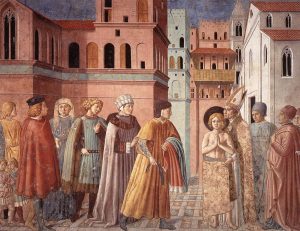When brought before the bishop, Francis would brook no delay nor hesitation in anything: nay, without waiting to be spoken to and without speaking he immediately put off and cast aside all his garments and gave them back to his father. Moreover he did not even keep his drawers but stripped himself stark naked before all the bystanders. But the bishop, observing his disposition, and greatly wondering at his fervor and steadfastness, arose forthwith, gathered him into his arms and covered him with the mantle which he himself was wearing.
Thomas of Celano, Vita Beati Francisci (“The Life of Blessed Francis”; often called the “First Life”)
Born in Assisi in 1181 or 1182 to Pietro and Pica Bernardone, Francis was born into a world of wealth and opulence. His father was a cloth merchant, supplying cloth to Medieval versions of Ralph Lauren.
Francis went to war at age 20 and was taken prisoner for almost a year. He was released and became seriously ill, which began a major turn in his life. His conversion took some time and involved numerous moments. With his return to Assisi, a spiritual change commenced. Francis, like society in his time, had a repulsion of lepers, and an encounter with a leper changed his heart. In one renowned episode, he went to the tattered small church of San Damiano, where Christ on the cross came to life and told him: “Go, Francis, and repair my Church in ruins.”
The culmination of his conversion, perhaps, could be said to have happened when Francis’ father, Pietro, questioned his son’s generosity and servitude to the poor. While standing before the bishop of Assisi, Francis stripped off his clothes and renounced his paternal inheritance.
The image above portrays Francis’ renunciation. Consuming two thirds of the foreground with the townspeople, Pietro Bernardone carries his son’s clothes on his left arm, and holds a belt in his right hand. A narrow space separates him from Francis, who is seen at prayer. The bishop covers the saint with his vestment, underscoring the religious nature of the scene. The contrasting depiction of the father and son expresses the dramatic nature of their conflict, supported by the arrangement of two opposing groups of figures: a secular group and a religious one. The fresco’s explanatory inscription reads: QUALITER B. F. CORA(M) EPISCOPO ASISII REN(UNTIA)VIT PATRI HEREDITATEM PATERNAM ET O(M)NIA VESTIMENTA ET FEMORALIA PATRI REIECIT – “How St Francis renounces his father’s inheritance before the bishop of Assisi and his father, and throws his upper garment and hose down before his father.” Francis’ renunciation was a rejection of the consumer society that was represented in his father’s way of life. Going naked was his public commitment to enter into an entirely different way of life committed to his heavenly Father. In saying he would no longer call Pietro Bernadone his “father” on earth (which he did so for the rest of his life), Francis now entered into solidarity with all of the children of the one he would call “Our Father” in heaven.
Amid plaster of Paris depictions of St. Francis, we tend to lose something of the revolutionary and radical nature of his life. Quite literally, for St. Francis, his clothes were an obstacle to his radical call in following Jesus. For Francis, no dependable security was to be found in clothing, shelter, wealth, or fame. These were the things that might have kept him in the kingdom of this world and prohibited his access to the kingdom of heaven.
This evocative action by St. Francis of Assisi gives us much to consider. From his encounter with the leper, Francis said he felt mercy or compassion. The lepers of Francis’ day were those separated from society. Are those making our clothes separated from us as well? According to Pope Francis, such a degree of separation based on our consumerism creates indifference in a way that blots out compassion. While we may not be called to strip in the city square, we know as well that our clothes, how we treat and pay those who make them, and how our clothing harms the environment are obstacles in our discipleship and living in right relationship with God, with neighbor, and with creation. One simple step that does not require stripping before town and bishop is to take the St. Vincent Pledge. The pledge calls us to:
Pray for the cultivation of solidarity between the consumers of clothing with the people who produce them in order to create sustainable communities through a more just economy. Learn about and educate others on the real consequences (both negative and positive) of globalized supply chains, especially in the clothing industry. Assess how we — as individuals and in our families, faith communities and places of employment — are able to confront the ’globalization of indifference” in the clothing industry by taking greater responsibility for the unintended consequences of our behavior as consumers. Act to change our choices and behaviors as consumers to improve the lives of the people who make our clothing and other goods in the global economy. Advocate for Catholic principles, priorities, and values with retailers, brand owners and government bodies concerning the wages and working conditions of the people who make our clothing.
St. Francis understood that his conversion required him to change his relationship with everything, even his clothes.

